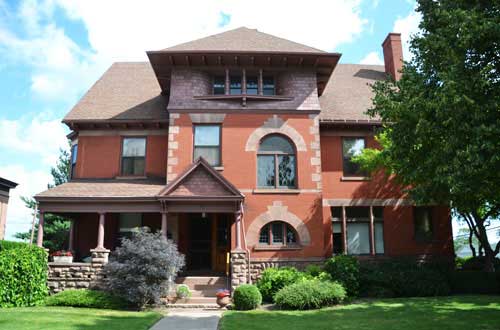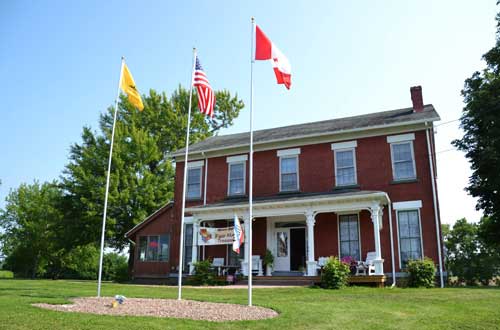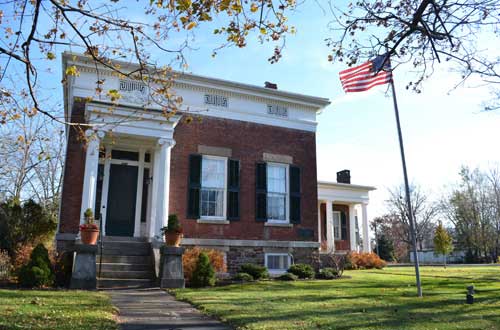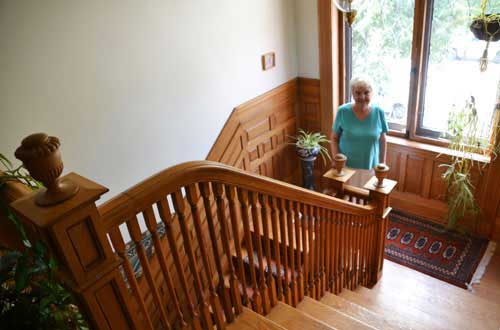10 stops are featured on museum’s Christmas Tour of Homes

Photos by Tom Rivers: Harriette Greaser’s house was built in 1893 at the corner of East State and Platt streets and is listed on the National Register of Historic Places.
ALBION – The Cobblestone Society and Museum has lined up 10 fabulous stops for their annual Christmas Tour of Homes from 2 to 7 p.m. on Dec. 7.
Participants can choose to drive themselves or take advantage of a tour bus option. Seating on the bus is limited, so tickets should be purchased early.
“Each of our stops will be a pleasure to behold,” said Doug Farley, director of the Cobblestone Museum. “We are pleased to partner with others in our community to showcase the richness of rural life in Orleans County at Christmas.”
Sites on this year’s tour include the Cobblestone Church at Childs; Fairhaven Treasures; the homes of Mark and Brenda Radzinski, Roger and Ingrid LaMont and David and Army Sidari; the DAR House; Waterman Park; First Presbyterian Church of Albion; the Queen Anne Manse of Harriet Greaser’s; and the Pullman Universalist Church.
Pat Morrisey and Toni Plummer will host tours of the Cobblestone Museum Church. In 1833, the First Universalist Society was organized at Fairhaven (now Childs) and a building committee consisting of John Proctor, Joseph Billings and William W. Ruggles was selected. Built in the Federal style, the Universalist Church represents the oldest cobblestone church in North America.
In 1960, the New York Convention of Universalists declared the Childs church abandoned and had considered selling it. To avoid potential use by commercial interests, the Cobblestone Society Museum was formed and purchased the building. It was during that time, in the 1960s, that the museum carefully repaired and restored the interior and exterior.
The interior of the church is arranged to look as it would have in the 1880s.

Fairhaven Treasures is at the southeast corner of routes 98 and 104 in the historic district at Gaines.
At Fairhaven Treasures, across the street from the Cobblestone Church, Ray Burke and Carol Culhane will welcome visitors. Burke purchased the home, built in the 1830s (the same decade as the Cobblestone Church) and he and Culhane have turned it into a Christmas paradise and gift shop.
The stately home is of brick construction with two parlors and a grand foyer. The name for the shop harkens back to an early era when the hamlet of Childs was called Fair Haven. The home boasts six fireplaces and open hearth cooking is still on display in the kitchen.
Visitors will be enchanted to look through an original guest book from Charles Howard’s Santa Claus School.
Mark and Brenda Radzinski’s home at 12799 Oak Orchard Rd. was originally built in 1890 and has been renovated with several additions before 1960. Visitors will see a large collection of handmade vintage Christmas quilts and enjoy a tasty treat during their visit.
Roger and Ingrid LaMont’s home at 3027 Densmore Rd. was built in 1912-1913. This Queen Anne/Victorian home features grand porches and an elegant suite of living areas. Continuously owned (and nearly continuously occupied) by the LaMont family for three generations, the home boasts many original lead windows and numerous antique furnishings. The front sitting room commands a view of a seven-foot tall custom-designed stained glass window gracing the stairwell. Other features include three sets of pocket doors leading to the dining room with original light fixtures, a living room with tiled fireplace and an updated kitchen. Many photographs and items displayed throughout the home reflect the rich history of this seven-generation farm family.
David and Amy Sidari will welcome guests to their home at 3300 Oak Orchard Rd. (Route 98), Albion. Franklin and Eleanor Roosevelt visited this home numerous times when the Ryans lived there. The Ryans invited the entire town to a buffet when Roosevelt was governor in the late 1920s.
In 1930, while touring the state to speak to Democratic women, Eleanor had dinner with the Ryans at their home and that same evening gave a speech at the Orleans Chapter DAR House.

The DAR House is part of the Christmas Tour of Homes on Dec. 7. The house was first built in 1840 on North Main Street at the Linwood Street intersection. The house was enlarged by Orson Tousley in the mid-1800s. The Greek Revival building is listed on the National Register of Historic Places.
The Orleans Chapter DAR House is located at 249 North Main St. The National Society Daughters of the American Revolution was founded in 1890, during a time that was marked by a revival in patriotism. Women felt the desire to express their patriotic feelings and were frustrated by their exclusion from men’s organizations formed to perpetuate the memory of ancestors who fought to make this country free and independent. As a result, a group of pioneering women in the nation’s capital formed their own organization and the Daughters of the American Revolution has carried the torch of patriotism ever since.
The Orleans DAR was organized in 1925, but by 1928, membership had grown so rapidly that holding meetings in private homes was no longer an option. Realizing the need for a meeting space for the chapter, Emma Reed Webster purchased this brick residence from the Church Family in 1929. the beautiful period woodwork is left intact, and the house is graced with period furniture, antiques and a large collection of artifacts.
South of the Erie Canal on Main Street, between eastside buildings, is Waterman Park, where a Santa mural was designed and painted by Stacey Kirby Steward, an Albion graduate. This 24-foot-long mural was a project initiated by Albion Rotary Club to commemorate the life and work of Charles W. Howard, as well as to highlight Albion’s extraordinary downtown and Courthouse Square.
Howard founded the world’s only Santa Claus School in Albion in 1937 and served as Santa in Macy’s Thanksgiving Day parade for nearly 20 years. He is known for dedicating his life to establishing a high standard for Santas everywhere. He died in 1966, but his school continues today in his name in Midland, Mich.
The First Presbyterian Church of Albion, located at 29 East State St., will highlight its sanctuary restoration and Christmas décor.

Harriette Greaser is pictured with the staircase made of golden oak at her home on East State Street, which is the former manse of the First Presbyterian Church in Albion.
When Elizur Kirke Hart died in 1873, he left $50,000 to the Presbyterian Church, directing that a new edifice be erected. According to legend, he also stipulated that he wanted the new church to have a steeple taller than the one on the local Baptist Church. Hence, the most dominating landmark at the Courthouse Square is the Presbyterian Church spire, reaching 175 feet in height. It is also the highest point in Orleans County.
The church is constructed entirely of brown Medina sandstone, quarried locally in 1874. The Gothic Revival style emulates European cathedrals of the 13th century. Stained glass windows in the Tiffany style were installed 100 years ago, replacing the original stained glass. Solid walnut woodwork is a treasure in itself.
Next door at 31 East State St., is the Harriette Greaser’s Queen Anne Presbyterian Manse.
The home was financed by Presbyterian Church members with large contributions by the Hart family. Two houses were moved off the lot to make way for construction of the manse. The church owned the home for 93 years, and it was sold to Philip and Harriette Greaser in January 1987.
The manse was one of the first to have all-electric lighting in Albion. Downstairs woodwork is golden oak and staircase panels are quartered-sawn oak. The kitchen is red birch, while the upstairs is cucumber wood, a type of poplar with a green line running through the boards. The wood ceiling in the kitchen is maple.
The Pullman Universalist Church at 10 East Park St. is the final stop on the tour. The building was designed in the style of Old English Gothic with Richardsonian Romanesque features. Designer Solon S. Beman found rough-hewn locally quarried pink Medina sandstone complimentary to the simple forms and heavy proportions of the Richardsonian style.
Built by George Pullman, inventor of the Pullman sleeping car, in honor of his parents, the main entrance is made of a series of stone moldings, with oak plank doors and decorative wrought iron hinges. The church can seat 300 (400 with the wide eastside doors opened to the parlor).
The church sanctuary contains 41 stained glass windows by Tiffany Glass and Decorating Company of New York City. The church houses a Johnson pipe organ with stenciled gold leaf pipes from the Tiffany Studios.
Self-drive tickets for the tour are $15 for Cobblestone Society members and $20 for others.
Bus tour tickets are $40 for members and $45 for all others.
Tickets are available by calling the museum at (585) 589-9013 or logging on to the website at www.CobblestoneMuseum.org.





































































